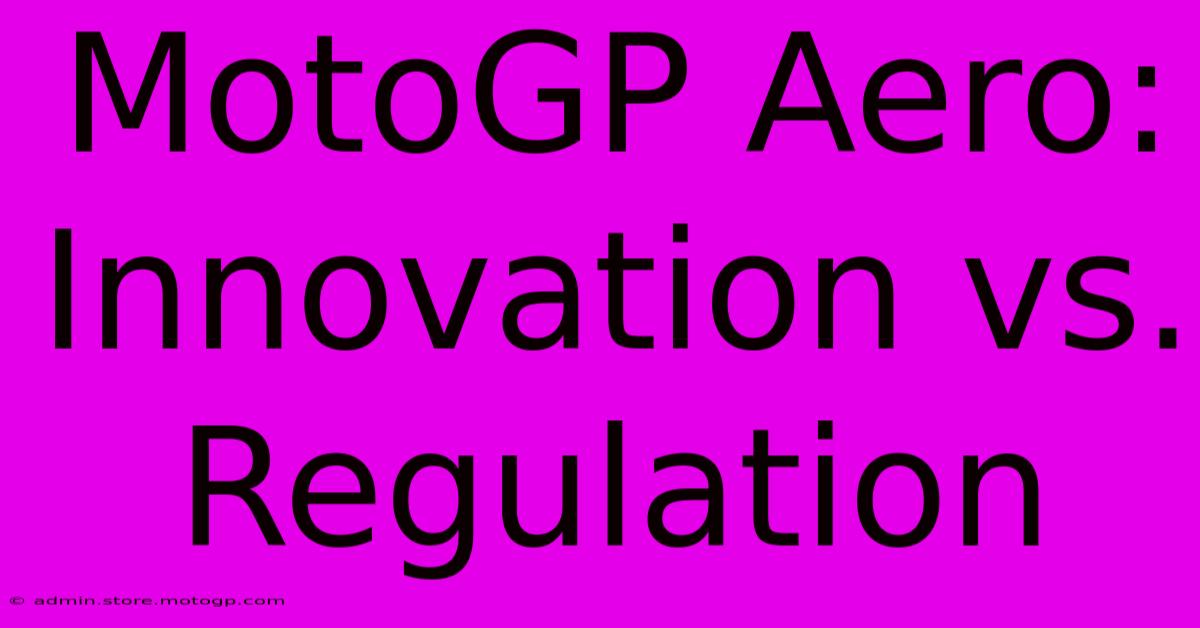MotoGP Aero: Innovation Vs. Regulation

Table of Contents
MotoGP Aero: Innovation vs. Regulation – A Balancing Act
MotoGP, the pinnacle of motorcycle racing, is a relentless pursuit of speed and performance. Aerodynamics play a crucial role, with teams constantly pushing the boundaries of innovation to gain even the slightest advantage. However, this innovation is constantly being checked by increasingly strict regulations, creating a fascinating dynamic between technological advancement and sporting fairness. This article delves into the complex relationship between MotoGP aero innovation and the regulations designed to control it.
The Aerodynamic Arms Race: Pushing the Limits of Performance
Aerodynamics in MotoGP are not just about speed; they significantly impact stability, cornering, and braking. Winglets, fairing designs, and underbody aerodynamics all contribute to a bike's overall performance. Teams employ sophisticated Computational Fluid Dynamics (CFD) simulations and wind tunnel testing to optimize these elements.
The Role of Winglets: Downforce and Stability
Winglets, those small aerodynamic appendages attached to the fairing, generate downforce, pressing the bike firmly onto the track. This increased grip allows riders to accelerate harder out of corners, brake later, and carry more speed through turns. The development of winglets has been a significant area of innovation, with teams constantly refining their design to maximize downforce while minimizing drag. Initially relatively simple, winglets have evolved into complex, multi-element designs, each carefully shaped to optimize airflow.
Fairing Design: A Symphony of Airflow
The fairing itself is a crucial aerodynamic component. Its shape and surface texture are meticulously designed to manage airflow around the bike, minimizing drag and maximizing downforce. Streamlining, air channels, and carefully sculpted surfaces all play a part in achieving this delicate balance. The development of new materials, such as carbon fiber composites, allows for even more intricate and lightweight designs.
The Regulatory Response: Maintaining Fair Competition
The constant push for aerodynamic advantage has led to increasingly stringent regulations. The governing body, Dorna Sports, imposes rules aimed at preventing teams from gaining an unfair advantage through overly complex or effective aerodynamic devices. These regulations often involve limitations on:
- Winglet size and shape: Restrictions on the dimensions and overall design of winglets prevent teams from creating excessively effective downforce-generating devices.
- Fairing dimensions and materials: Regulations control the overall shape and size of the fairing, as well as the materials used in its construction.
- Underbody aerodynamics: Rules are in place to limit the extent to which teams can manipulate airflow under the bike.
These regulations aim to level the playing field, preventing teams with superior resources from dominating through sheer aerodynamic prowess. This is crucial for ensuring a competitive and exciting championship.
The Ongoing Debate: Innovation vs. Standardization
The balance between innovation and regulation remains a delicate one. While regulations are essential to maintain fairness, they can also stifle innovation and limit the development of exciting new technologies. There's an ongoing debate about the extent to which regulations should restrict aerodynamic development. Some argue that stricter regulations are necessary to control costs and ensure parity, while others believe that allowing more freedom for innovation leads to a more exciting and technologically advanced sport.
The Future of MotoGP Aero
The future of aerodynamics in MotoGP will likely involve a continuing dance between innovation and regulation. Teams will continue to push the boundaries of what's possible, finding creative ways to improve performance within the constraints of the regulations. Expect to see continued refinements in winglet design, fairing shapes, and underbody aerodynamics, alongside ongoing discussions and adjustments to the regulatory framework. The quest for ultimate performance in MotoGP is a never-ending story, a captivating blend of cutting-edge technology and controlled competition.
Keywords: MotoGP, Aerodynamics, Winglets, Fairing, Downforce, Drag, CFD, Wind Tunnel, Regulation, Dorna Sports, Innovation, Competition, Motorcycle Racing, Aero, MotoGP Aero Regulations, MotoGP Technology.

Thank you for visiting our website wich cover about MotoGP Aero: Innovation Vs. Regulation. We hope the information provided has been useful to you. Feel free to contact us if you have any questions or need further assistance. See you next time and dont miss to bookmark.
Featured Posts
-
Moto Gp Horsepower What Makes These Bikes So Special
Feb 19, 2025
-
Moto Gp Helmet Tech Protecting Champions Inspiring Riders
Feb 19, 2025
-
Find Your Flow Cota Track Day
Feb 19, 2025
-
Get Immersed In The Action Austin Gp Sprint Race Vip Access
Feb 19, 2025
-
Lub Si Cota A Path To Inner Peace
Feb 19, 2025
